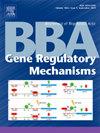新的红细胞特异性调控元件对plklr基因转录激活的影响。
IF 3.1
3区 生物学
Q3 BIOCHEMISTRY & MOLECULAR BIOLOGY
Biochimica et Biophysica Acta-Gene Regulatory Mechanisms
Pub Date : 2025-09-16
DOI:10.1016/j.bbagrm.2025.195116
引用次数: 0
摘要
丙酮酸激酶L/R (PKLR)基因编码丙酮酸激酶的L型和R型同工型,在哺乳动物中催化糖酵解的最后一步。l型同工酶主要存在于肝细胞中,而r型同工酶仅在红细胞中产生。为了研究PKLR基因对r型同工酶的转录激活,我们分析了红系K562和非红系HUVEC细胞的染色质特征,包括DNase I敏感性、组蛋白修饰和增强子-启动子相互作用。在K562细胞的pkr位点附近发现了可能的调控元件,包括一个启动子和两个增强子。与活性增强子相关的组蛋白标记H3K4me1和H3K27ac通过组蛋白甲基转移酶突变导致PKLR转录显著减少,而附近基因的转录保持稳定。这些调控元件被红系特异性转录因子GATA1和TAL1高度占据。任何一个因子的缺失都会破坏局部H3K27ac,减少染色质环因子的募集,导致pkr转录减少。此外,CRISPR/ cas9介导的缺失显著降低了PKLR转录,证明了它们在功能上的重要性。总的来说,这些发现强调了这些调控元件在激活红细胞plklr转录中的重要作用,并强调了红细胞特异性因子对其功能的要求。本文章由计算机程序翻译,如有差异,请以英文原文为准。
Transcriptional activation of the PKLR gene by novel erythroid-specific regulatory elements
The pyruvate kinase L/R (PKLR) gene encodes the L- and R-type isoforms of pyruvate kinase, which catalyze the final step of glycolysis in mammals. The L-type isozyme is mainly found in liver cells, whereas the R-type isozyme is produced specifically in erythroid cells. To investigate the transcriptional activation of the PKLR gene for the R-type isozyme, we analyzed chromatin features—including DNase I sensitivity, histone modifications, and enhancer–promoter interactions—in erythroid K562 and non-erythroid HUVEC cells. Putative regulatory elements, including a promoter and two enhancers, were identified near the PKLR locus in K562 cells. Depletion of H3K4me1 and H3K27ac, histone marks associated with active enhancers, through mutation of histone methyltransferases led to a marked reduction in PKLR transcription, while transcription of a nearby gene remained stable. These regulatory elements were highly occupied by the erythroid-specific transcription factors GATA1 and TAL1. Loss of either factors disrupted local H3K27ac and reduced the recruitment of chromatin-looping factors, resulting in decreased PKLR transcription. Furthermore, CRISPR/Cas9-mediated deletion of the putative regulatory elements significantly diminished PKLR transcription, demonstrating their functional importance. Collectively, these findings highlight the essential role of these regulatory elements in activating PKLR transcription in erythroid cells and emphasize the requirement of erythroid-specific factors for their function.
求助全文
通过发布文献求助,成功后即可免费获取论文全文。
去求助
来源期刊
CiteScore
9.20
自引率
2.10%
发文量
63
审稿时长
44 days
期刊介绍:
BBA Gene Regulatory Mechanisms includes reports that describe novel insights into mechanisms of transcriptional, post-transcriptional and translational gene regulation. Special emphasis is placed on papers that identify epigenetic mechanisms of gene regulation, including chromatin, modification, and remodeling. This section also encompasses mechanistic studies of regulatory proteins and protein complexes; regulatory or mechanistic aspects of RNA processing; regulation of expression by small RNAs; genomic analysis of gene expression patterns; and modeling of gene regulatory pathways. Papers describing gene promoters, enhancers, silencers or other regulatory DNA regions must incorporate significant functions studies.

 求助内容:
求助内容: 应助结果提醒方式:
应助结果提醒方式:


